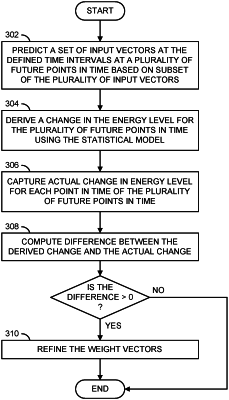| CPC G01R 31/3648 (2013.01) [B60W 30/0956 (2013.01); B60W 50/0097 (2013.01); G01C 21/3469 (2013.01); G01L 5/13 (2013.01); G05B 13/048 (2013.01); G05B 23/0254 (2013.01); G05D 1/0214 (2013.01); G05D 1/0221 (2013.01); G06F 17/18 (2013.01); G06N 5/048 (2013.01); G06N 20/00 (2019.01); G06Q 10/04 (2013.01); G08G 1/0104 (2013.01); G08G 1/0125 (2013.01); G08G 1/0129 (2013.01); G01L 3/26 (2013.01); G01L 17/00 (2013.01); G01R 31/367 (2019.01)] | 18 Claims |

|
1. A method performed by one or more processors for predicting energy consumption of a vehicle using a statistical model and indicating, one of visually and audibly, results corresponding to a predicted change in energy level to a driver of the vehicle, said method comprising:
predicting a set of future input vectors for said vehicle at defined time intervals corresponding to a plurality of future points in time based on a subset of a plurality of reference input vectors previously generated at the defined time intervals at a plurality of previous points in time, the subset including a most recent reference input vector, wherein an energy level of said vehicle is associated with each reference input vector of said plurality of reference input vectors at each previous point in time of said plurality of previous points in time, each reference input vector comprises a vehicle input vector and a database input vector associated with each point in time of said plurality of previous points in time, said vehicle input vector for each defined time interval is based at least in part on one or more vehicle operating parameters, and said database input vector for each defined time interval is based at least in part on a plurality of environmental data and information about a road condition;
predicting a change in said energy level of said vehicle using a processor and said statistical model, wherein (i) the change in said energy level comprises a function of corresponding future input vectors and an associated weighting vector, said weighting vector having been derived using said plurality of reference input vectors and associated energy levels at each point in time of said plurality of previous points in time, and representing an overall effect of each input vector on energy consumption of said vehicle, and (ii) said change in said energy level is predicted based on a regression analysis of said energy level associated with each of said reference input vectors; and
providing results corresponding to the predicted change in said energy level to an audio-video output unit of said vehicle and providing the results, using the audio-video output unit, to a driver of the vehicle;
wherein each vehicle input vector comprises a plurality of sensor data and each database input vector comprises a plurality of database data;
wherein said statistical model comprises at least one of a linear function and a periodic function of at least one of a stored energy of the vehicle at each point in time, each vehicle input vector, and each database input vector for each defined time interval, and wherein the statistical model is generated using machine learning based on an equation for each input vector; and
wherein said plurality of sensor data is captured for a vehicle location environment, a vehicle equipment profile, and a driver behavior profile at each point in time of said plurality of previous points in time.
|